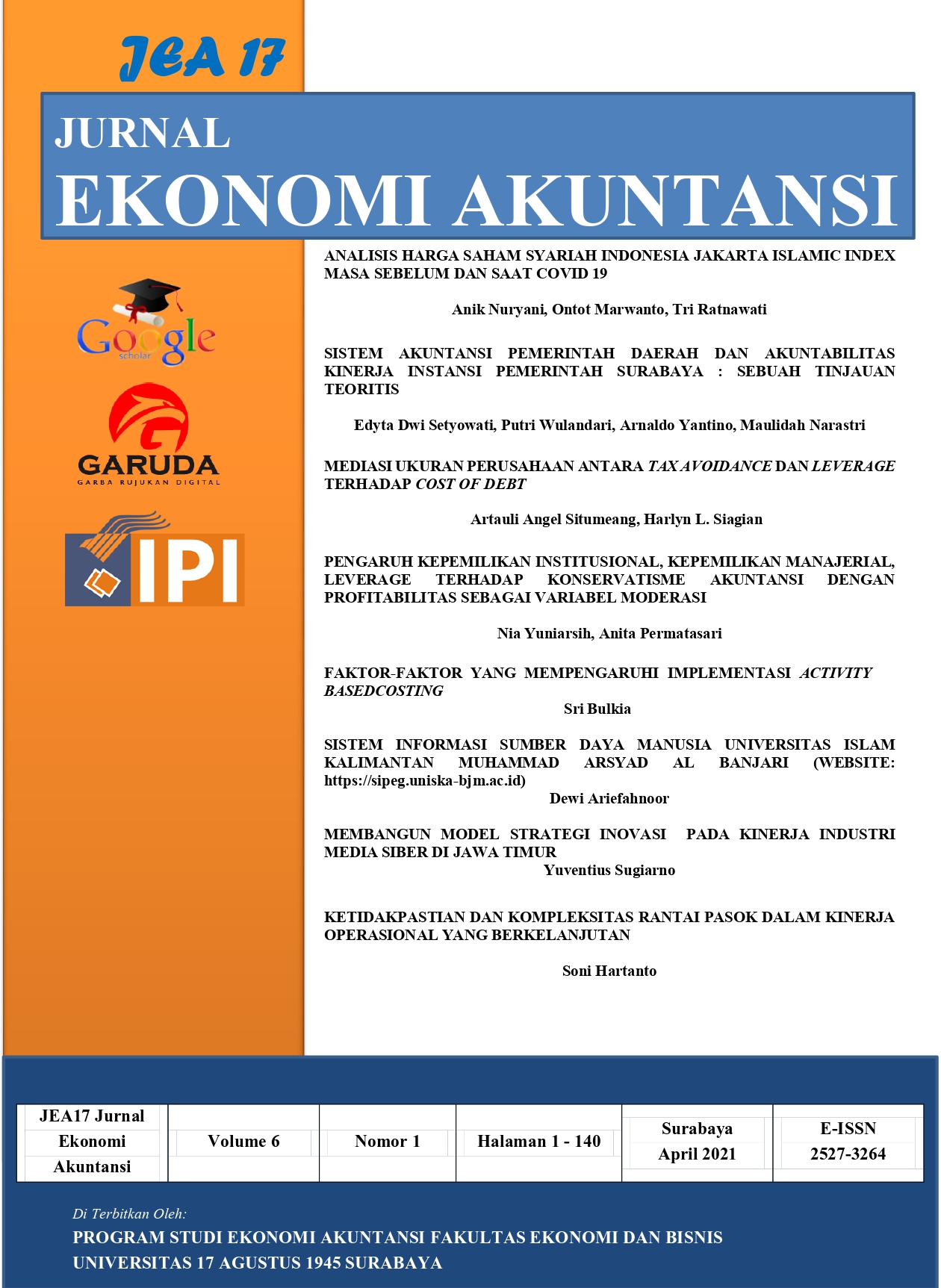PENGARUH KEPEMILIKAN INSTITUSIONAL, KEPEMILIKAN MANAJERIAL, LEVERAGE TERHADAP KONSERVATISME AKUNTANSI DENGAN PROFITABILITAS SEBAGAI VARIABEL MODERASI
DOI:
https://doi.org/10.30996/jea17.v6i1.5224Keywords:
Keywords, Institusional Ownership, Managerial Ownership, Leverage, Profitability, Accounting ConservatismAbstract
The principle of conservatism is the principle of prudence against an uncertain situation to avoid excessive optimism from management and company owners. Consequently, if there is a condition that is likely to cause loss, expense or debt, the loss, cost or debt must be recognized immediately. The variables used in this study include Institutional Ownership, Managerial Ownership, Leverage, Profitability and Accounting Conservatism. This research is a quantitative research conducted on manufacturing companies listed on the Indonesia Stock Exchange for the period 2016-2018. The results of this study are institutional ownership has an effect on accounting conservatism; Managerial ownership affects accounting conservatism, leverage affects accounting conservatism, profitability affects accounting conservatism, and profitability moderates the variables of institutional ownership, managerial ownership, and leverage on accounting conservatism.
Downloads
References
Abdurrahman, M. A., & Ermawati, W. J. (2018). Pengaruh Leverage, Financial Distress dan Profitabilitas terhadap Konservatisme Akuntansi pada Perusahaan Pertambangan di Indonesia Tahun 2013-2017. Jurnal Manajemen Dan Organisasi (JMO), 9(3), 164–173.
Ahmed, A. ., & Duellman, S. (2007). Accounting conservatism and board of director characteristics: An empirical analysis. Journal of Accounting and Economics.
Alkurdi, A., Al-Nimer, M., & Mohammad Dabaghia. (2017). Accounting Conservatism and Ownership Structure Effect: Evidence from Industrial and Financial Jordanian Listed Companies. International Journal of Economics and Financial, 7(2), 608–619.
Dewi, N. K. S. L., & Suryanawa, I. K. (2014). Pengaruh Struktur Kepemilikan Manajerial,Leverage, dan Financial Distress Terhadap Konservatisme Akuntansi. E-Jurnal Akuntansi Universitas Udayana, 7(1), 223–234.
Jensen, M. C., & Meckling, W. H. (1976). Theory of the Firm: Managerial Behavior : Agency Costs and Ownership Structure. Journal of Financial Economics, 3(4), 305–360.
Lafond, R., & Roychowdhury, S. (2007). Managerian Ownership and Accounting Conservatism. Ssrn.
Lasdi, L. (2009). Pengujian Determinan Konservatisme Akuntansi. Journal Akuntansi Kontemporer, 1(1).
Lin, L. (2016). Institutional ownership composition and accounting conservatism. Review of Quantitative Finance and Accounting, 46, 359–385.
Lo, E. W. (2005). Pengaruh Tingkat Kesulitan Keuangan Perusahaan terhadap Konservatisme Akuntansi. Simposium Nasional Akuntansi VIII, 396 – 440.
Pramana, A. D. (2010). Pengaruh Mekanisme Corporate Governance, Profitabilitas, dan Leverage Terhadap Konservatisme Akuntansi Di Indonesia. Universitas Sebelas Maret Surakarta.
Sari, D. (2004). Hubungan Antara Konservatisme Akuntansi dengan Konflik Bondholders-Shareholders Seputar Kebijakan Dividen dan Peringkat Obligasi. Jurnal Akuntansi Dan Keuangan Indonesia.
Suprihastini, E., & Pusparini, H. (2007). Pengaruh Tingkat Kesulitan Keuangan dan Tingkat Hutang Terhadap Konservatisme Akuntansi pada Perusahaan Manufaktur yang Terdaftar di Bursa Efek Jakarta 2001-2005. Jurnal Riset Akuntansi, 6.
Wahidahwati. (2002). Kepemilikan Manajerial dan Agency Conflict: Analisis Persamaan Simultan Non Linier dari Kepemilikan Manajerial, Penerimaan Resiko (Risk Taking), Kebijakan Utang dan Kebijakan Dividen. Simposium Nasional Akuntansi V, 601–614.
Wardhani, R. (2008). Tingkat Konservatisme Akuntansi di Indonesia dan Hubungannya dengan Karakteristik Dewan sebagai Salah Satu Mekanisme Corporate Governance. Simposium Nasional Akuntansi XI.
Xu, X., Wang, X., & Han, N. (2012). Accounting conservatism, ultimate ownership and Investment efficiency. China Finance Review International. China Finance Review International, 2(1), 55–77.
Downloads
Published
Issue
Section
License
Authors whose manuscript is published will approve the following provisions:
- The right to publication of all journal material published on the JEA17: Jurnal Ekonomi Akuntansi website is held by the editorial board with the author's knowledge (moral rights remain the property of the author).
- The formal legal provisions for access to digital articles of this electronic journal are subject to the terms of the Creative Commons Attribution-ShareAlike (CC BY-SA) license, which means JEA17: Jurnal Ekonomi Akuntansi reserves the right to store, modify the format, administer in the database, maintain and publish articles without requesting permission from the Author as long as it keeps the Author's name as the owner of Copyright.
- Printed and electronically published manuscripts are open access for educational, research, and library purposes. In addition to these objectives, the editorial board shall not be liable for violations of copyright law.











